国际经济学作业复习资料第二章
国际经济学第二章

60
0
X
图 2-4(b)小囯的要素增长和贸易
三、 小囯的技术进步和贸易与财富
• 中性技术进步使得两种商品生产在相对价格不变 的条件下以相同比率增长。
• 只有在可出口商品生产中的中性技术进步是顺贸 易的。
• 不同类型的技术进步,会增加或降低贸易量,但 总是会增加小国的社会财富。
一、劳动增长与资本积累
• 图2-1表明了假设A国各类型要素增长的情况。对B国的说 明完全相似,由A可以推及B。图2-1中的左图说明假设A 国的劳动与资本两要素增加一倍的平衡增长情况。右图 重复了A国增长前的生产可能性曲线,并显示了另两条 分别为仅劳动或资本增加一倍时的生产可能性曲线。
Y
Q 2Y Q1Y
三、技术进步
• 当两种商品生产中的中性技术进步速度相同时,一国的 生产可能性曲线按照技术进步发生的速度向所有方向均 匀外移,这与生产要素平均增长时的效应相同。这种技 术进步的类型即图2-1左图所示。
Y QY2
QY1
A
A
A ’ B QX1
B
B’ QX2 X
0
图 2-3 中性技术进步
第二节
小国的经济增长与国际贸易
三、技术进步
• 过去的经验研究揭示了发达国家的实际人均收入 的增加主要是依靠技术进步,而资本积累的作用 则十分有限。然而,由于技术进步的类型不同, 而且不同的技术进步在每一种或同时在两种商品 生产过程中有着不同的比率,和要素增长分析相 比,技术进步的分析比较复杂。
三、技术进步
技术进步类型: (1)中性技术进步。中性技术进步是指劳动和资 本的生产效率(productivity)同比例增加。 (2)劳动节约型技术进步。劳动节约型技术进步 是指资本要素生产效率的增加大于劳动要素生产 效率的增加。 (3)资本节约型技术进步。资本节约型技术进步 是指劳动要素生产效率的增加大于资本要素生产 效率的增加。
国际经济学期末复习资料-国际经济学习题库
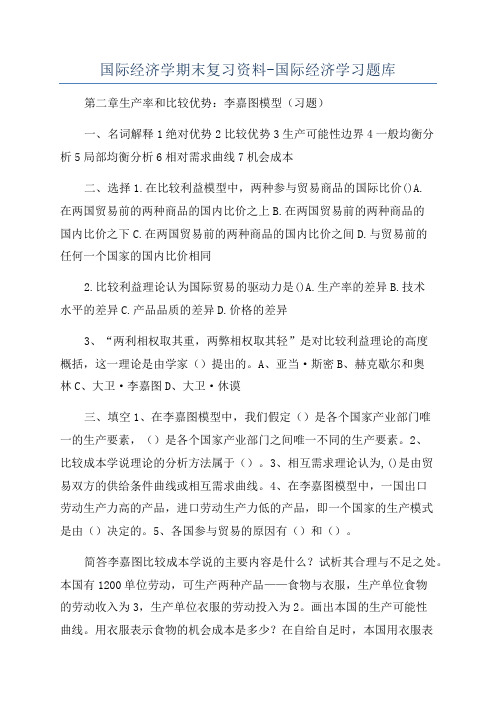
国际经济学期末复习资料-国际经济学习题库第二章生产率和比较优势:李嘉图模型(习题)一、名词解释1绝对优势2比较优势3生产可能性边界4一般均衡分析5局部均衡分析6相对需求曲线7机会成本二、选择1.在比较利益模型中,两种参与贸易商品的国际比价()A.在两国贸易前的两种商品的国内比价之上B.在两国贸易前的两种商品的国内比价之下C.在两国贸易前的两种商品的国内比价之间D.与贸易前的任何一个国家的国内比价相同2.比较利益理论认为国际贸易的驱动力是()A.生产率的差异B.技术水平的差异C.产品品质的差异D.价格的差异3、“两利相权取其重,两弊相权取其轻”是对比较利益理论的高度概括,这一理论是由学家()提出的。
A、亚当·斯密B、赫克歇尔和奥林C、大卫·李嘉图D、大卫·休谟三、填空1、在李嘉图模型中,我们假定()是各个国家产业部门唯一的生产要素,()是各个国家产业部门之间唯一不同的生产要素。
2、比较成本学说理论的分析方法属于()。
3、相互需求理论认为,()是由贸易双方的供给条件曲线或相互需求曲线。
4、在李嘉图模型中,一国出口劳动生产力高的产品,进口劳动生产力低的产品,即一个国家的生产模式是由()决定的。
5、各国参与贸易的原因有()和()。
简答李嘉图比较成本学说的主要内容是什么?试析其合理与不足之处。
本国有1200单位劳动,可生产两种产品——食物与衣服,生产单位食物的劳动收入为3,生产单位衣服的劳动投入为2。
画出本国的生产可能性曲线。
用衣服表示食物的机会成本是多少?在自给自足时,本国用衣服表示的食物的相对价格是多少?在古典贸易模型中,假设A国有120名劳动力,B国有50名劳动力,如果生产棉花的话,A国人均产量是2吨,B国也是2吨。
如果生产大米,A国人均产量是10吨,B国是16吨。
画出两国的生产可能性曲线并分析两国中哪一国拥有生产大米的绝对优势?哪一国拥有生产大米的比较优势?假定中国总劳动为600小时生产每单位钢铁y需要4小时,而生产每单位大米某需要2小时,中国的福利函数位U=某y.求封闭中国的福利水平。
国际经济学作业答案第二章

Chapter 2 World Trade—An OverviewMultiple Choice Questions1. What percent of all world production of goods and services is exported to other countries?(a) 10%(b) 25%(c) 50%(d) 100%(e) None of the aboveAnswer: B2.What percent of all world imports of goods and services were exported?(a) 10%(b) 25%(c) 50%(d) 100%(e) None of the above.Answer: D3. What percent of all world consumption (private and public, including real investment) was imported?(a) 10%(b) 25%(c) 50%(d) 100%(e) None of the above.Answer: B4. The gravity model, that states that size matters,predicts that the weight of the traded good will________ related to its likelihood to be exported(a) be directly(b) be inversely(c) not be(d) All of the above(e) None of the aboveAnswer: E5. The gravity model offers a logical explanation for the fact that(a) Trade between Asia and the U.S. has grown faster than NAFTA trade.(b) Trade in services has grown faster than trade in goods.(c) Trade in manufactures has grown faster than in agricultural products(d) Intra-European Union trade exceeds International Trade of the European Union.(e) None of the aboveAnswer: D6. The gravity model suggests that over time(a) trade between neighboring countries will increase(b) trade between all countries will increase(c) world trade will eventually be swallowed by a black hole.(d) trade between Earth and other planets will become important(e) None of the aboveAnswer: E7. The gravity model explains why(a) trade between Sweden and Germany exceeds that between Sweden and Spain(b) countries with oil reserves tend to export oil.(c) capital rich countries export capital intensive products(d) intra-industry trade is relatively more important than other forms of trade between neighboringcountries.(e) None of the aboveAnswer: A8. According to the gravity model, a characteristic that tends to affect the probability of trade existingbetween any two countries is(a) their cultural affinity(b) the average weight/value of their traded goods(c) their colonial—historical ties(d) the distance between them(e) the number of varieties produced on the average by their industries.Answer: D9. The one single trade partner country of the U.S. is(a) United Kingdom(b) Canada(c) Mexico(d) Japan(e) IsraelAnswer: B10. In general which of the following tend to promote the probability of trade volumes between twocountries(a) Linguistic and/or cultural affinity(b) Historical ties(c) Sizes of economies(d) Mutual membership in preferential trade agreements(e) All of the aboveAnswer: E11. Since World War II (the early 1950s), the proportion of most countries’ production beisome other country(a) remained constant(b) increased(c) decreased(d) fluctuated widely with no clear trend(e) both (a) and (d) aboveAnswer: B12. Since World War II, the likelihood that foreign markets would gain importance in the averageexporters’ as a source of profits(a) remained constant(b) increased(c) decreased(d) fluctuated widely with no clear trend(e) both (a) and (d) aboveAnswer: B13. Since World War II, the likelihood that any single item in the typical consumption basket of aconsumer in the U.S. originated outside of the U.S.(a) remained constant(b) increased(c) decreased(d) fluctuated widely with no clear trend(e) both (a) and (d) aboveAnswer: B14. Since World War II, the likelihood that the job a new college graduate will be directly or indirectlyaffected by world trade(a) remained constant(b) increased(c) decreased(d) fluctuated widely with no clear trend(e) both (a) and (d) aboveAnswer: B13 / 715. Since World War II, the relative importance of raw materials, including oil, in total world trade(a) remained constant(b) increased(c) decreased(d) fluctuated widely with no clear trend(e) both (a) and (d) aboveAnswer: C16. In the current Post-Industrial economy, international trade in services (including banking andfinancial services)(a) dominates world trade(b) does not exist(c) is relatively small(d) is relatively stagnant(e) None of the aboveAnswer: C17. In the pre-World War I period, the U.S. exported primarily(a) manufactured goods(b) services(c) primary products including agricultural(d) technology intensive products(e) None of the aboveAnswer: C18. In the pre-World War I period, the United Kingdom exported primarily(a) manufactured goods(b) services(c) primary products including agricultural(d) technology intensive products(e) None of the aboveAnswer: A19. In the pre-World War I period, the United Kingdom imported primarily(a) manufactured goods(b) services(c) primary products including agricultural(d) technology intensive products(e) None of the aboveAnswer: C20. In the present, most of the exports from China are in(a) manufactured goods(b) services(c) primary products including agricultural(d) technology intensive products(e) None of the aboveAnswer: A21. Which of the following does not explain the extent of trade between Ireland and the U.S.?(a) Historical ties(b) Cultural Linguistic ties(c) Gravity model(d) Multinational Corporations(e) None of the aboveAnswer: CEssay Questions1. When comparing the composition of world trade in the early 20th Century to the early 21st Century,we find major compositional changes. These include a relative decline in agricultural and primary-products (including raw materials). How would you explain this in terms of broad historicaldevelopments during this period?Answer: The typical composition of world production during this period experienced majorchanges. Focusing on today’s Industrialized Countries (primarily members of the OECD),the industrial-employment composition was focused primarily on agriculture. Most valuewas in land. The predominant single consumption category was food. Since then, theeconomies shifted from the agricultural to the manufacturing sectors (continuing trendsbegun over a century earlier in the industrial revolution). Incomes rose, and consumptionshifted in favor of (increasingly affordable) manufactures. Both income and priceelasticities were greater in manufactures than in agricultural products. At the same timethere was a steady tendency for synthetic (manufactured) inputs to replace agriculturalbased raw materials and industrial inputs. Hence, trade and of course international tradeconformed to overall changes in patterns of world production and consumption.2. In the past half century, the developing countries have experienced major compositional shifts fromexports of primary products (including agricultural and raw materials) to exports of manufactures.How might you explain this in terms of broad historical developments during this period?Answer: Any discussion of the export experience of the developing countries must first clarify the problem of definitional inclusion. In particular, the exports of the (non-OECD) developingcountries, has become increasingly dominated by the experience of a relatively smallnumber of countries in South-East Asia, termed the New Industrialized Countries (NICs).Since they experienced both very rapid increases in their exports, and very rapid increasesin the manufactured component of their exports, their experience alone may explain thebulk of the observed phenomenon. Many would exclude the NICs from the developingcountry category so as to be able to focus the discussion on a more representative sampleof (the over 100) developing countries. More recently, a second wave of East Asiancountries, notably including China have replicated the experience of the NICs, and thisagain muddies the water for one interested in focusing on the export experience of thegrowing heterogenous category, developing countries.15 / 7Another explanation of the growing dependence on manufactured exports on the part ofthe developing countries, follows the answer to question 1 above. Since the consumer( including industrial consumer) markets in OECD countries were rapidly shifting awayfrom primary products, these markets were rapidly disappearing.In addition, in the world markets for primary products was generally limited by low priceand especially income elasticities; agricultural sectors tended to be highly and rigidlyprotected in potential OECD markets; and escalating effective tariff structures leviedsystematically large levels of protection against the primary exports of the developingcountries; success in world exports had to be pursued outside of the traditional primaryexports of these countries.3. The Neoclassical Heckscher-Ohlin model assumes that all producers of any industrial product hasknowledge of, and may avail itself of the same production technology available to producers in anyother country. Many have flagged this identical technology assumption as an unrealistic assumption.During the past half century, the relative importance of the Multinational Corporations (MNCs) inidenticalworld trade has steadily increased. How would this trend affect the realism of the “technology” assumption?Answer: Noting that MNC plants tend to use more labor intensive production processes incountries where labor tends to be relatively cheap (both in “low” tech , e.g. Nike, and“high tech,” e.g. Motorola), one may argue that MNCs use different technologies indeveloping countries. However, this is a gross misunderstanding of the identicaltechnology assumption . It is axiomatically obvious that if the same MNC is producingsomething in both labor abundant and labor scarce using different processes, itnevertheless has knowledge (intimate knowledge in the case of proprietary patentedprocesses) of available technology. The fact that the MNC may choose not to apply thesame degree of capital intensity in environments with greatly different relative factorprices in no way lessens the fact that the Heckscher-Ohlin identical technologyassumption is strengthened due to the growing relative strength of MNCs in developingcountries. An additional fact that strengthens this argument is that, as compared to theearly 1950s, a growing proportion of MNCs are themselves based in developing countries,such as China and Brazil.4. One of the major political developments of the past several decades is the growing size andeconomic/monetary integration of the European Union. What effect do you think this will have oninternational trade between countries?Answer: The growing economic integration between the various countries of Europe, both the oldand existing members of the European Union (EU) and the new countries joining it(including perhaps soon, Turkey), means that the barriers to trade are steadily falling in aregion that has traditionally dominated world trade. The common monetary unit should initself go far to promote inter-country trade within the growing EU (judging by thepositive historical effect of a single currency in the U.S.). The standardization oftransportation (including railroad gauges, highway signs etc.) and product codes will alsopromote expansion of intra-EU trade. The decline in the probability of political conflictassociated with this comprehensive economic union, plus conscious attempts to cooperatein fiscal and monetary policy stances again point to growing international trade, allowingthese countries to increasingly enjoy the fruits of potential positive scale economies, andmore traditional classical and neo-classical gains from trade. The scale economies willalso tend to increase trade between the EU and other countries.5. The Services sector has been steadily rising in relative importance in GDP of the United States, as-tradables” (e.g. it well as elsewhere around the world. Since “services” have been identified as “no is difficult to export haircuts), it may be argued that this trend will likely slow the rapid growth ininternational trade. Discuss.Answer: This argument stands on questionable logical foundations. The past half century has seena steady growth in the absolute and relative importance of international trade. This trendhas been reversed only by global conflicts, i.e. the two World Wars. This trend hasremained steady and robust despite major compositional shifts (e.g. from primary tomanufacturing), and location shifts (e.g., the sudden rise of NICs as significant group ofexporters). The trend will probably continue into the reasonable future, fueled by bothsuper-regional preferential trade regions and a growing impact of the multilateral forces,represented institutionally by the World Trade Organization (WTO)—as illustrated by therecent abolishment of the epitome cartelized trade, the world trade in textiles. Driven bytechnology—especially in the areas of communication and transportation—a reversal ofthe growing trade trend is not likely in the near future. In any case, many-fact quite tradable. Examples would be financial services, long-distance teaching, “helpdesk” outsourcing, consult ing and management services and others. In fact, when a touristgets a haircut, we see that even haircuts become a “tradable” service.17 / 7。
国际经济学复习

第2章 劳动生产率和比较优势:李嘉图模型1、本国共有1200单位的劳动,能生产两种产品:苹果和香蕉。
苹果的单位产品投入是3,香蕉的单位产品投入是2。
a. 画出本国的生产可能性边界。
生产苹果量:12003=400 生产香蕉量:12002=600b. 用香蕉衡量的苹果的机会成本是多少?==1.5c. 贸易前,苹果对香蕉的相对价格是多少?为什么?在没有贸易前,苹果对香蕉的相对价格为它们的相对单位产品的劳动投入:P A /P B =a A /a B =3/2=1.5劳动的流动性可以使得各个部门的工资相同,竞争可以使商品的价格等于它们的生产成本,这样,相对价格等于相对成本。
相对成本等于工资*商品的单位产品劳动投入。
因为各部门工资相等,价格比等于单位产品的劳动投入。
在没有贸易的情况下,在完全竞争中,劳动是个体厂商为达到利润最大化而决定生产及供应量的唯一要素,因此当P A /P B =a A /a B 时,本国生产两种产品。
2、本国的情况与第1题相同。
外国拥有800单位的劳动。
外国苹果的单位产品投入是5,香蕉的单位产品劳动投入是1。
香蕉苹果400a. 画出外国的生产可能性边界。
生产苹果量:800/5=160 生产香蕉量:800/1=800b. 画出世界。
相对供给曲线3、假定世界相对需求的表示如下:对苹果的需求/对香蕉的需求=香蕉价格/苹果价格 a. 在相对供给曲线的同一张图上画出世界相对需求曲线。
D A /D B =P B /P A当市场达到均衡时,有D A /D B =(Q A +QA*)/(Q B +Q B *)=(P A /P B )-1因此RD 曲线是Y=1/X 形式的苹果的相对价格PA/PB800160苹果4 5 (QA+QA*)/(QB+QB*)12 3 0.250.5 1a*LA /a*LB =5 a LA /a LB =1.5b. 苹果的均衡相对价格是多少?苹果的均衡相对价格取决于RD 曲线与RS 曲线的交点 RD :Y=1/X RS :X [0,0.5) Y=1.5X=0.5Y [1.5,5]X (0.5,] Y=5X=0.5,Y=2P e a/P e b=2 (世界均衡价格)c. 描述本题的贸易模式。
国际经济学第2章(Helen)

David Ricardo,1772-1823
13
(一)概述
涵义:两国都能生产同样两种产品的条件下,其中一国在 两种产品生产上的劳动生产率均高于另一国,该国可以专 门生产优势较大的产品,处于劣势地位的另一国可以专门 生产劣势较小的产品;通过国际分工与贸易,双方仍可从 国际贸易中获利。 两利相权取其重,两弊相权取其轻。 由David Ricardo(1772-1823)提出。英国工业革命深入 发展时期的经济学家,1817年出版了主要著作《政治经济 学和赋税原理》,提出了比较成本理论。
25
(2)赫克歇尔——俄林定理(Heckscher-Ohlin Theorem)
在各国生产要素存量一定的情况下,一国将生产和出口密集使用 其丰裕要素的产品,进口密集使用其稀缺要素的产品。 推理过程:
国际贸易 商品的价格差
生产产品的成本差别
生产要素的价格不同
假定中国和美国生产同种产品 的技术相同,生产布需要2单 位资本和5单位劳动。中国每 单位资本和劳动的价格分别为 6美元和1美元,而美国则分别 为3美元和4美元,结果中国每 单位布的成本为2x6+5x1=17 美元,而美国为2x3+5x4=26 美元。
毛呢产量 2.7单位
所需劳动 190人/年
4
交换后: (假定英国以1单位毛呢交换葡萄牙1单位葡萄酒) 酒消费量 毛呢消费量 英 1单位 1.7单位 葡 1.375单位 1单位 而分工前:
英 葡
酒消费量 1单位 1单位
毛呢消费量 1单位 1单位
5
(二)具体内容 1、理论分析的假定条件
(1)生产过程中只投入一种生产要素——劳动力; (2)世界上只有两个国家——中国和美国; (3)这两个国家都能生产两种产品——小麦和布; (4)劳动力在一国范围内各部门间自由流动; (5)劳动力在部门间转移时机会成本不变; (6)生产要素在两国之间不能流动; (7)两国经济资源都充分利用; (8)贸易平衡;
国际经济学第二章
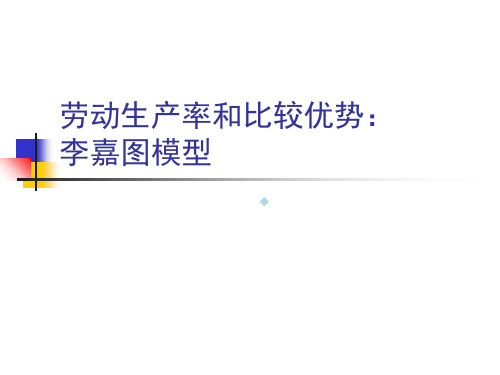
单一要素经济
图 2-1: 本国生产可能性曲线
本国酒产量, QW, (加仑)
P L/aLW
o
斜率的绝对值等于用葡萄酒 衡量的奶酪的机会成本
F L/aLC 本国奶酪产量, QC,
(磅)
单一要素经济
■相对价格与供给 每种产品生产的数量是由价格所决定的 用产品Y(酒)来表示的产品X(奶酪)
单一要素世界中的贸易
■第三,当PC/PW>a*LC/a*LW时,本国和外 国都专业化生产奶酪,将没有酒的生产。 因此奶酪的供给是无限的。
■第四,当PC/PW=a*LC/a*LW时,外国工人 对于奶酪和酒的生产无差异。RS曲线为 直线。
■第奶五酪,的当相a对LC供/aL给W<是P(LC//PaWLC<)/a(L*L*C/a/a*L*LWW)时,
单一要素经济
■假定我们研究一个经济,并将其称为“本 国”(home)。在此经济中,假定
劳动力是唯一的生产要素 只生产两种商品(奶酪和酒) 劳动力供应在两国是固定的 生产每种商品的劳动生产率是固定的 市场结构是完全竞争的
单一要素经济
■本国经济的技术可以用劳动生产率来表述,即 单位劳动投入(unit labor requirement)
—化假生定产a奶LC酪/aLW<a*LC/a*LW ,本国将专业 —本当国P将C/专PW业<a化LC生/a产LW酒或PC/aLC<PW/aLW时, —专同业样化,生当产P酒C/PW<a*LC/a*LW时,外国将 ■其次,当奶酪的相对价格为
P酪C和/PW酒=是aL无C/a差LW异,的本。国RS工曲人线对是于一生条产直奶线
比较优势的概念
■机会成本(opportunity cost) 资源的稀缺性意味着生产出某种产品就必须
国际经济学第二章课后作业
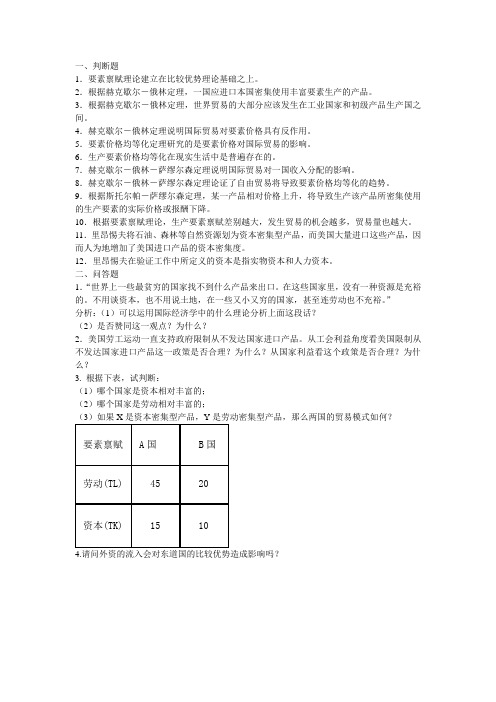
一、判断题1.要素禀赋理论建立在比较优势理论基础之上。
2.根据赫克歇尔-俄林定理,一国应进口本国密集使用丰富要素生产的产品。
3.根据赫克歇尔-俄林定理,世界贸易的大部分应该发生在工业国家和初级产品生产国之间。
4.赫克歇尔-俄林定理说明国际贸易对要素价格具有反作用。
5.要素价格均等化定理研究的是要素价格对国际贸易的影响。
6.生产要素价格均等化在现实生活中是普遍存在的。
7.赫克歇尔-俄林-萨缪尔森定理说明国际贸易对一国收入分配的影响。
8.赫克歇尔-俄林-萨缪尔森定理论证了自由贸易将导致要素价格均等化的趋势。
9.根据斯托尔帕-萨缪尔森定理,某一产品相对价格上升,将导致生产该产品所密集使用的生产要素的实际价格或报酬下降。
10.根据要素禀赋理论,生产要素禀赋差别越大,发生贸易的机会越多,贸易量也越大。
11.里昂惕夫将石油、森林等自然资源划为资本密集型产品,而美国大量进口这些产品,因而人为地增加了美国进口产品的资本密集度。
12.里昂惕夫在验证工作中所定义的资本是指实物资本和人力资本。
二、问答题1.“世界上一些最贫穷的国家找不到什么产品来出口。
在这些国家里,没有一种资源是充裕的。
不用谈资本,也不用说土地,在一些又小又穷的国家,甚至连劳动也不充裕。
”分析:(1)可以运用国际经济学中的什么理论分析上面这段话?(2)是否赞同这一观点?为什么?2.美国劳工运动一直支持政府限制从不发达国家进口产品。
从工会利益角度看美国限制从不发达国家进口产品这一政策是否合理?为什么?从国家利益看这个政策是否合理?为什么?3. 根据下表,试判断:(1)哪个国家是资本相对丰富的;(2)哪个国家是劳动相对丰富的;。
国际经济学作业答案-第二章
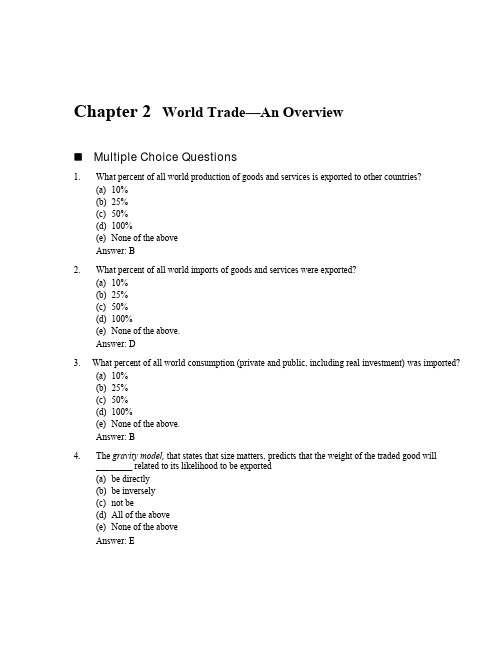
Chapter 2 World Trade—An OverviewMultiple Choice Questions1. What percent of all world production of goods and services is exported to other countries?(a) 10%(b) 25%(c) 50%(d) 100%(e) None of the aboveAnswer: B2.What percent of all world imports of goods and services were exported?(a) 10%(b) 25%(c) 50%(d) 100%(e) None of the above.Answer: D3. What percent of all world consumption (private and public, including real investment) was imported?(a) 10%(b) 25%(c) 50%(d) 100%(e) None of the above.Answer: B4. The gravity model, that states that size matters,predicts that the weight of the traded good will________ related to its likelihood to be exported(a) be directly(b) be inversely(c) not be(d) All of the above(e) None of the aboveAnswer: E12 Krugman/Obstfeld •Seventh Edition5. The gravity model offers a logical explanation for the fact that(a) Trade between Asia and the U.S. has grown faster than NAFTA trade.(b) Trade in services has grown faster than trade in goods.(c) Trade in manufactures has grown faster than in agricultural products(d) Intra-European Union trade exceeds International Trade of the European Union.(e) None of the aboveAnswer: D6. The gravity model suggests that over time(a) trade between neighboring countries will increase(b) trade between all countries will increase(c) world trade will eventually be swallowed by a black hole.(d) trade between Earth and other planets will become important(e) None of the aboveAnswer: E7. The gravity model explains why(a) trade between Sweden and Germany exceeds that between Sweden and Spain(b) countries with oil reserves tend to export oil.(c) capital rich countries export capital intensive products(d) intra-industry trade is relatively more important than other forms of trade between neighboringcountries.(e) None of the aboveAnswer: A8. According to the gravity model, a characteristic that tends to affect the probability of trade existingbetween any two countries is(a) their cultural affinity(b) the average weight/value of their traded goods(c) their colonial—historical ties(d) the distance between them(e) the number of varieties produced on the average by their industries.Answer: D9. The one single trade partner country of the U.S. is(a) United Kingdom(b) Canada(c) Mexico(d) Japan(e) IsraelAnswer: BChapter 2 World Trade—An Overview 13 10. In general which of the following tend to promote the probability of trade volumes between twocountries(a) Linguistic and/or cultural affinity(b) Historical ties(c) Sizes of economies(d) Mutual membership in preferential trade agreements(e) All of the aboveAnswer: E11. Since World War II (the early 1950s), the proportion of most countries’ production being used insome other country(a) remained constant(b) increased(c) decreased(d) fluctuated widely with no clear trend(e) both (a) and (d) aboveAnswer: B12. Since World War II, the likelihood that foreign markets would gain importance in the averageexporters’ as a source of profits(a) remained constant(b) increased(c) decreased(d) fluctuated widely with no clear trend(e) both (a) and (d) aboveAnswer: B13. Since World War II, the likelihood that any single item in the typical consumption basket of aconsumer in the U.S. originated outside of the U.S.(a) remained constant(b) increased(c) decreased(d) fluctuated widely with no clear trend(e) both (a) and (d) aboveAnswer: B14. Since World War II, the likelihood that the job a new college graduate will be directly or indirectlyaffected by world trade(a) remained constant(b) increased(c) decreased(d) fluctuated widely with no clear trend(e) both (a) and (d) aboveAnswer: B14 Krugman/Obstfeld •Seventh Edition15. Since World War II, the relative importance of raw materials, including oil, in total world trade(a) remained constant(b) increased(c) decreased(d) fluctuated widely with no clear trend(e) both (a) and (d) aboveAnswer: C16. In the current Post-Industrial economy, international trade in services (including banking andfinancial services)(a) dominates world trade(b) does not exist(c) is relatively small(d) is relatively stagnant(e) None of the aboveAnswer: C17. In the pre-World War I period, the U.S. exported primarily(a) manufactured goods(b) services(c) primary products including agricultural(d) technology intensive products(e) None of the aboveAnswer: C18. In the pre-World War I period, the United Kingdom exported primarily(a) manufactured goods(b) services(c) primary products including agricultural(d) technology intensive products(e) None of the aboveAnswer: A19. In the pre-World War I period, the United Kingdom imported primarily(a) manufactured goods(b) services(c) primary products including agricultural(d) technology intensive products(e) None of the aboveAnswer: CChapter 2 World Trade—An Overview 1520. In the present, most of the exports from China are in(a) manufactured goods(b) services(c) primary products including agricultural(d) technology intensive products(e) None of the aboveAnswer: A21. Which of the following does not explain the extent of trade between Ireland and the U.S.?(a) Historical ties(b) Cultural Linguistic ties(c) Gravity model(d) Multinational Corporations(e) None of the aboveAnswer: CEssay Questions1. When comparing the composition of world trade in the early 20th Century to the early 21st Century,we find major compositional changes. These include a relative decline in agricultural and primary-products (including raw materials). How would you explain this in terms of broad historicaldevelopments during this period?Answer: The typical composition of world production during this period experienced major changes. Focusing on today’s Industrialized Countries (primarily members of the O ECD),the industrial-employment composition was focused primarily on agriculture. Most valuewas in land. The predominant single consumption category was food. Since then, theeconomies shifted from the agricultural to the manufacturing sectors (continuing trendsbegun over a century earlier in the industrial revolution). Incomes rose, and consumptionshifted in favor of (increasingly affordable) manufactures. Both income and priceelasticities were greater in manufactures than in agricultural products. At the same timethere was a steady tendency for synthetic (manufactured) inputs to replace agriculturalbased raw materials and industrial inputs. Hence, trade and of course international tradeconformed to overall changes in patterns of world production and consumption.2. In the past half century, the developing countries have experienced major compositional shifts fromexports of primary products (including agricultural and raw materials) to exports of manufactures.How might you explain this in terms of broad historical developments during this period?16 Krugman/Obstfeld •Seventh EditionAnswer: Any discussion of the export experience of the developing countries must first clarify the problem of definitional inclusion. In particular, the exports of the (non-OECD) developingcountries, has become increasingly dominated by the experience of a relatively smallnumber of countries in South-East Asia, termed the New Industrialized Countries (NICs).Since they experienced both very rapid increases in their exports, and very rapid increasesin the manufactured component of their exports, their experience alone may explain thebulk of the observed phenomenon. Many would exclude the NICs from the developingcountry category so as to be able to focus the discussion on a more representative sampleof (the over 100) developing countries. More recently, a second wave of East Asiancountries, notably including China have replicated the experience of the NICs, and thisagain muddies the water for one interested in focusing on the export experience of thegrowing heterogenous category, developing countries.Chapter 2 World Trade—An Overview 17 Another explanation of the growing dependence on manufactured exports on the part ofthe developing countries, follows the answer to question 1 above. Since the consumer( including industrial consumer) markets in OECD countries were rapidly shifting awayfrom primary products, these markets were rapidly disappearing.In addition, in the world markets for primary products was generally limited by low priceand especially income elasticities; agricultural sectors tended to be highly and rigidlyprotected in potential OECD markets; and escalating effective tariff structures leviedsystematically large levels of protection against the primary exports of the developingcountries; success in world exports had to be pursued outside of the traditional primaryexports of these countries.3. The Neoclassical Heckscher-Ohlin model assumes that all producers of any industrial product hasknowledge of, and may avail itself of the same production technology available to producers in any other country. Many have flagged this identical technology assumption as an unrealistic assumption.During the past half century, the relative importance of the Multinational Corporations (MNCs) in world trade has steadily increased. How w ould this trend affect the realism of the “identicaltechnology” assumption?Answer: Noting that MNC plants tend to use more labor intensive production processes in countries where labor tends to be relatively cheap (both in “low” tech , e.g. Nike, and“high tech,” e.g. Motorola), one may argue that MNCs use different technologies indeveloping countries. However, this is a gross misunderstanding of the identicaltechnology assumption . It is axiomatically obvious that if the same MNC is producingsomething in both labor abundant and labor scarce using different processes, itnevertheless has knowledge (intimate knowledge in the case of proprietary patentedprocesses) of available technology. The fact that the MNC may choose not to apply thesame degree of capital intensity in environments with greatly different relative factorprices in no way lessens the fact that the Heckscher-Ohlin identical technologyassumption is strengthened due to the growing relative strength of MNCs in developingcountries. An additional fact that strengthens this argument is that, as compared to theearly 1950s, a growing proportion of MNCs are themselves based in developing countries,such as China and Brazil.4. One of the major political developments of the past several decades is the growing size andeconomic/monetary integration of the European Union. What effect do you think this will have on international trade between countries?Answer: The growing economic integration between the various countries of Europe, both the old and existing members of the European Union (EU) and the new countries joining it(including perhaps soon, Turkey), means that the barriers to trade are steadily falling in aregion that has traditionally dominated world trade. The common monetary unit should initself go far to promote inter-country trade within the growing EU (judging by thepositive historical effect of a single currency in the U.S.). The standardization oftransportation (including railroad gauges, highway signs etc.) and product codes will alsopromote expansion of intra-EU trade. The decline in the probability of political conflictassociated with this comprehensive economic union, plus conscious attempts to cooperatein fiscal and monetary policy stances again point to growing international trade, allowingthese countries to increasingly enjoy the fruits of potential positive scale economies, andmore traditional classical and neo-classical gains from trade. The scale economies willalso tend to increase trade between the EU and other countries.18 Krugman/Obstfeld •Seventh Edition5. The Services sector has been steadily rising in relative importance in GDP of the United States, aswell as elsewhere around the world. Since “services” have been identified as “non-tradables” (e.g. it is difficult to export haircuts), it may be argued that this trend will likely slow the rapid growth in international trade. Discuss.Answer: This argument stands on questionable logical foundations. The past half century has seena steady growth in the absolute and relative importance of international trade. This trendhas been reversed only by global conflicts, i.e. the two World Wars. This trend hasremained steady and robust despite major compositional shifts (e.g. from primary tomanufacturing), and location shifts (e.g., the sudden rise of NICs as significant group ofexporters). The trend will probably continue into the reasonable future, fueled by bothsuper-regional preferential trade regions and a growing impact of the multilateral forces,represented institutionally by the World Trade Organization (WTO)—as illustrated by therecent abolishment of the epitome cartelized trade, the world trade in textiles. Driven bytechnology—especially in the areas of communication and transportation—a reversal ofthe growing trade trend is not likely in t he near future. In any case, many “services” are infact quite tradable. Examples would be financial services, long-distance teaching, “help-desk” outsourcing, consulting and management services and others. In fact, when a touristgets a haircut, we s ee that even haircuts become a “tradable” service.。
第二章(2)国际经济学

所谓机会成本指的是多生产1单位某产品就 必须牺牲另一产品的产量。那么,各国具体应当 专业化生产何种商品,并不是由生产商品耗费的 劳动量或实际支出成本来决定,而应该考察物品 的机会成本。与他国相比,某种产品的机会成本 如果低的话,那么该产品就具有比较优势,反之 则处于比较劣势。
二、机会成本一定条件下的生产可能性曲线
第二章 国际贸易的基础与得益
学习要点
1.比较优势与机会成本; 2.机会成本一定时的贸易基础及得益; 3.机会成本递增时的贸易基础及得益; 4.提供曲线、贸易条件及贸易利益的分配。
第一节
机会成本一定时的贸易基础 与贸易得益
一、比较优势与机会成本
哈 伯 勒 ( Gottfriod Haberler ) 是 奥 地 利著名经济学家。他在1936年出版的《国际贸 易 理 论 》 一 书 中 将 机 会 成 本 ( opportunity cost )或替代成本 (substitution cost) 的概 念引入到比较利益原理的分析中。
图2-6 机会成本递增时英国贸易前后的一般均衡
二、机会成本递增条件下的贸易基础与贸 易利益
(一)贸易基础及贸易后的一般均衡 (二)贸易利益 (三)需求情况不同产生的贸易与贸易利益的 来源
相对价格的差异也可能是需求差异引起的。
由于本国偏好的商品可能因为需求因素而价 格上升,那么本国不偏好的商品其价格相对偏低。
美国
60
160
C(万码/年)
120
80
三、社会无差异曲线与封闭状态下的一般均衡
(一)社会无差异曲线 社会无差异曲线( Community Indifference Curve,CIC)表示在同一消费效用水平或满足度 上,两种产品消费组合的轨迹。 无差异曲线的斜率是边际替代率(Marginal Rate of Substitution , MRS )。它表示在相同 的满足程度下,多增加一单位产品 X (横轴商品) 的消费,可以替代的Y(纵轴商品)消费的量。
《国际经济学》复习资料
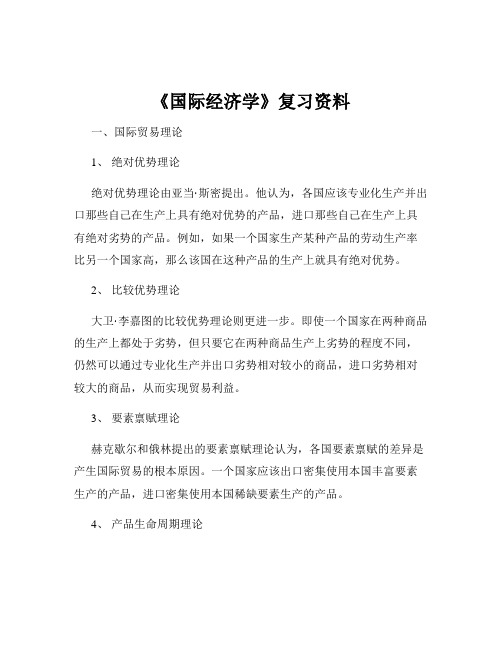
《国际经济学》复习资料一、国际贸易理论1、绝对优势理论绝对优势理论由亚当·斯密提出。
他认为,各国应该专业化生产并出口那些自己在生产上具有绝对优势的产品,进口那些自己在生产上具有绝对劣势的产品。
例如,如果一个国家生产某种产品的劳动生产率比另一个国家高,那么该国在这种产品的生产上就具有绝对优势。
2、比较优势理论大卫·李嘉图的比较优势理论则更进一步。
即使一个国家在两种商品的生产上都处于劣势,但只要它在两种商品生产上劣势的程度不同,仍然可以通过专业化生产并出口劣势相对较小的商品,进口劣势相对较大的商品,从而实现贸易利益。
3、要素禀赋理论赫克歇尔和俄林提出的要素禀赋理论认为,各国要素禀赋的差异是产生国际贸易的根本原因。
一个国家应该出口密集使用本国丰富要素生产的产品,进口密集使用本国稀缺要素生产的产品。
4、产品生命周期理论弗农的产品生命周期理论从动态的角度解释了贸易模式的变化。
产品通常会经历创新、成熟和标准化三个阶段,在不同阶段,生产和贸易的模式也会发生相应的变化。
5、规模经济理论克鲁格曼等经济学家提出的规模经济理论认为,规模经济是国际贸易产生的重要原因之一。
即使两国在要素禀赋和技术方面完全相同,但由于规模经济的存在,各国仍可以通过专业化生产和贸易来获得利益。
二、国际贸易政策1、关税关税是一国政府对进出本国关境的商品所征收的税收。
关税可以分为从量税、从价税和混合税等多种类型。
关税的经济效应包括价格效应、消费效应、生产效应、贸易效应和财政收入效应等。
2、非关税壁垒非关税壁垒的形式多种多样,如进口配额、自愿出口限制、技术性贸易壁垒、绿色贸易壁垒等。
这些措施对国际贸易的影响往往比关税更加复杂和隐蔽。
3、贸易保护主义的理论依据贸易保护主义的理论依据包括幼稚产业保护论、凯恩斯主义的贸易保护论等。
但需要注意的是,过度的贸易保护往往会带来一系列负面效应,如降低经济效率、引发贸易摩擦等。
三、国际金融1、外汇与汇率外汇是指以外币表示的可以用于国际结算的支付手段。
国际经济学(第2章)
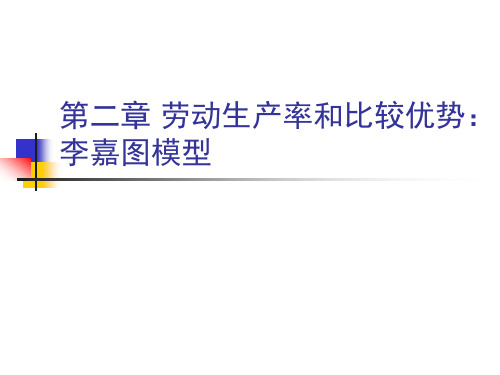
比较优势的概念
机会成本( 机会成本(opportunity cost) ) 资源的稀缺性意味着生产出某种产品就必须 放弃其他产品。因此, 放弃其他产品。因此,机会成本衡量的是生产 某种产品所耗费的同样资源如果用来生产另一 种产品的产出数量 ■比较优势(comparative advantage) 比较优势( ) 比较优势建立在机会成本的比较之上。 比较优势建立在机会成本的比较之上。如果 一个国家生产某种产品的机会成本较低, 一个国家生产某种产品的机会成本较低,则在 这种产品上具有比较优势
单一要素经济
■
生产可能性( 生产可能性(production possibilities) ) 生产可能性边界( 生产可能性边界( production possibilities frontier,PPF)指的是一国 , ) 最有效率生产出的两种产品的各种可能 组合 上述假设经济的生产可能性边界可以以 一下方程来表述: 一下方程来表述:
■
比较优势的概念
如果每一个国家按照比较优势( 如果每一个国家按照比较优势(较低的机会成 进行专业化( 本)进行专业化(specialization)生产,然后 )生产, 进行贸易,则这种贸易对双方都有好处。 进行贸易,则这种贸易对双方都有好处。 比较优势是如何决定的? ■比较优势是如何决定的? 对这一问题的回答将帮助我们了解国家间的 差异如何决定贸易模式( 差异如何决定贸易模式(the pattern of trade),即一个国家出口什么和进口什么 ),即一个国家出口什么和进口什么 ),
本章小结
李嘉图模型是一个最简单的模型, 李嘉图模型是一个最简单的模型,它揭示 了国家间的差异导致了贸易, 了国家间的差异导致了贸易,并获得了 贸易利益 在这一模型中,劳动是唯一的要素, ■在这一模型中,劳动是唯一的要素,国家 间的差异反映在劳动生产率的差异上 在李嘉图模型中, ■在李嘉图模型中,国家出口的产品时具有 劳动生产率比较优势的产品
国际经济学复习资料
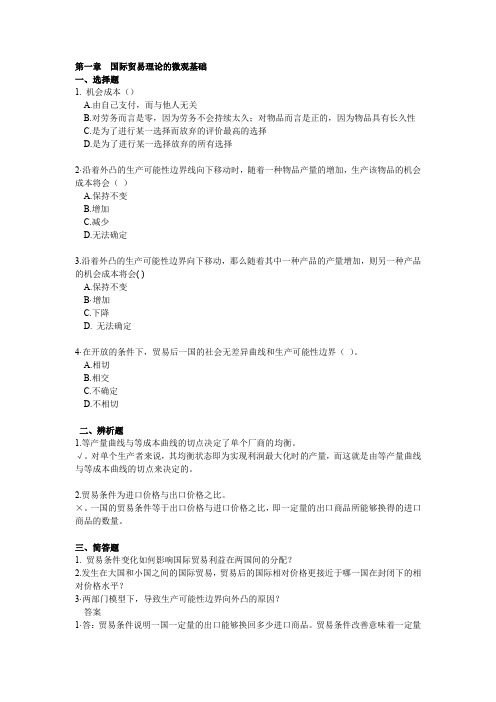
第一章国际贸易理论的微观基础一、选择题1. 机会成本()A.由自己支付,而与他人无关B.对劳务而言是零,因为劳务不会持续太久;对物品而言是正的,因为物品具有长久性C.是为了进行某一选择而放弃的评价最高的选择D.是为了进行某一选择放弃的所有选择2·沿着外凸的生产可能性边界线向下移动时,随着一种物品产量的增加,生产该物品的机会成本将会()A.保持不变B.增加C.减少D.无法确定3.沿着外凸的生产可能性边界向下移动,那么随着其中一种产品的产量增加,则另一种产品的机会成本将会( )A.保持不变B·增加C.下降D. 无法确定4·在开放的条件下,贸易后一国的社会无差异曲线和生产可能性边界()。
A.相切B.相交C.不确定D.不相切二、辨析题1.等产量曲线与等成本曲线的切点决定了单个厂商的均衡。
√。
对单个生产者来说,其均衡状态即为实现利润最大化时的产量,而这就是由等产量曲线与等成本曲线的切点来决定的。
2.贸易条件为进口价格与出口价格之比。
×。
一国的贸易条件等于出口价格与进口价格之比,即一定量的出口商品所能够换得的进口商品的数量。
三、简答题1. 贸易条件变化如何影响国际贸易利益在两国间的分配?2.发生在大国和小国之间的国际贸易,贸易后的国际相对价格更接近于哪一国在封闭下的相对价格水平?3·两部门模型下,导致生产可能性边界向外凸的原因?答案1·答:贸易条件说明一国一定量的出口能够换回多少进口商品。
贸易条件改善意味着一定量的出口商品能够换回更多的进口商品,所以出口国能够获得更多的贸易利益;而贸易条件恶化意味着一定量的出口商品只能够换回较少的进口商品,此时,进口国获得更多的贸易利益。
2.答:按照经济学的规范,小国通常是价格的接受者(Price taker)而非价格的制定者(price maker),所以在与大国的贸易中,小国通常会接受大国国内的价格,所以,贸易后的国际相对价格更接近于大国在封闭下的相对价格。
国际经济学第二章

按比较优势原则分工
表2-1(b)两国单位产出所需的劳动量 A国
X的劳动投入量 Y的劳动投入量 3 6
B国
12 8
表2-3(b)国际分工后生产变化的净效果 A国 B国 世界生产净变化
X Y +2 -1 -1 +1.5 +1 +0.5
习题3 答案提示
(1) 如果ax >bx,则称A国在X产品 产品上具有绝 国 产品 绝 对优势 (2)如果ax/ay>bx/by则称A国在X产品 A X产品上具有 比较优势, 比较优势, 比较优势,B国在Y产品 Y产品上具有比较优势, 比较优势 (3)当ay=by或者ay<by的时候,由ax >bx可 以推出ax/ay>bx/by,但是,当ay>by的时 候, ax >bx不能保证ax/ay>bx/by。所以, 即使一国在某一商品上具有绝对优势,也未 必具有比较优势。
X Y +2 -1 -1 +3 +1 +2
2.比较优势
表2-2(b)两国的劳动生产率 A国
X的劳动生产率 Y的劳动生产率 1/3 1/6
我们说A国 在X产品 优 势更为突出
B国
1/12 1/8
可见
两种产品的绝对优势程度并不相同 生产率
在X产品上 A国是B国的4倍 在Y产品上 A国是B国的4/3倍
定义:如果ax/ay>bx/by则称A国在X产品 产品上具有 国 产品 比较优势,B国在Y产品 比较优势, 国 产品上具有比较优势, 比较优势, 产品 比较优势
成本
定义:如果ax >bx则称A国在X 国 产品上具有绝对 产品 绝对 优势 如果by >ay则称B国在Y 国 产品上具有绝对 产品 绝对 优势
按绝对优势原则分工
国际经济学(chapter2)
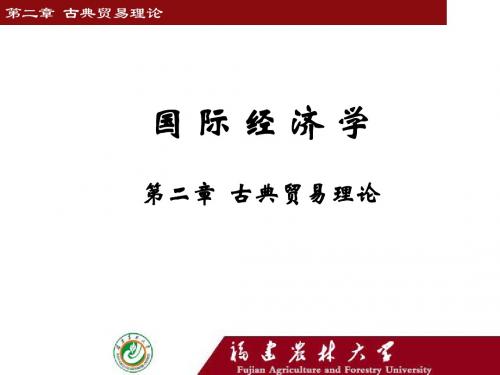
第二章 古典贸易理论
第一节 古典贸易理论的演变 一、重商主义(Mercantilism) 重商主义 “就象守财奴一样,双手抱住他心爱的钱袋, 用嫉妒和猜疑的目光打量着自己的邻居” ——恩格斯
第二章 古典贸易理论
1、背景知识
重商主义经济学时代:14世纪末到18世纪,全盛于16 重商主义经济学时代:14世纪末到18世纪,全盛于16 :14世纪末到18世纪 17世纪 17世纪下半叶开始瓦解 世纪, 世纪下半叶开始瓦解。 、17世纪,17世纪下半叶开始瓦解。这一时期正是 资本主义经济的资本原始积累阶段。 资本主义经济的资本原始积累阶段。 重商主义产生的时代背景: 重商主义产生的时代背景: 葡萄牙人在非洲海岸、 “ 葡萄牙人在非洲海岸 、 印度及整个远东地区 搜寻着黄金; 搜寻着黄金 ; 黄金这两个字变成了驱使西班牙人远 渡大西洋的符咒; 渡大西洋的符咒 ; 黄金也是白种人刚踏上新发现的 海岸时所追求的头一项重要的东西” 海岸时所追求的头一项重要的东西” 。
小麦
劳动投 入量 英国 美国 15 10 产出量 120 120 劳动投 入量 5 10
布
产出量 100 100
第二章 古典贸易理论
从表2-2可以看出, 从表 可以看出,进 可以看出 行国际分工之后, 行国际分工之后,整 个世界小麦的产出量 仍是240,没有变化, 仍是 ,没有变化, 但是布的产量增加到 400,比分工前增加 , 个单位。 了200个单位。这说 个单位 明,国际分工使两国 的资源得到了更有效 的利用。 的利用。
第二章 古典贸易理论
• 本国生产A、B、C、D四种产品的单位劳动 投入分别为14、21、3、4,外国生产这四 种产品的单位劳动投入分别为12、18、24 、30 ,根据斯密的绝对优势理论,本国的哪些具
国际经济学作业
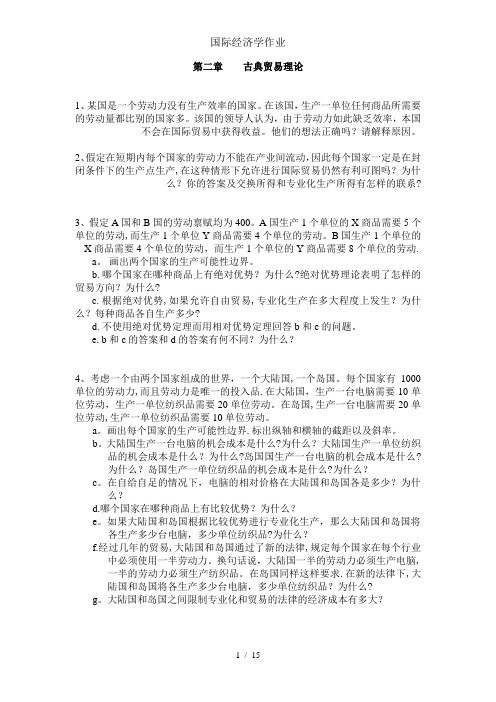
第二章古典贸易理论1、某国是一个劳动力没有生产效率的国家。
在该国,生产一单位任何商品所需要的劳动量都比别的国家多。
该国的领导人认为,由于劳动力如此缺乏效率,本国不会在国际贸易中获得收益。
他们的想法正确吗?请解释原因。
2、假定在短期内每个国家的劳动力不能在产业间流动,因此每个国家一定是在封闭条件下的生产点生产,在这种情形下允许进行国际贸易仍然有利可图吗?为什么?你的答案及交换所得和专业化生产所得有怎样的联系?3、假定A国和B国的劳动禀赋均为400。
A国生产1个单位的X商品需要5个单位的劳动,而生产1个单位Y商品需要4个单位的劳动。
B国生产1个单位的X商品需要4个单位的劳动,而生产1个单位的Y商品需要8个单位的劳动.a。
画出两个国家的生产可能性边界。
b. 哪个国家在哪种商品上有绝对优势?为什么?绝对优势理论表明了怎样的贸易方向?为什么?c. 根据绝对优势,如果允许自由贸易,专业化生产在多大程度上发生?为什么?每种商品各自生产多少?d. 不使用绝对优势定理而用相对优势定理回答b和c的问题。
e. b和c的答案和d的答案有何不同?为什么?4、考虑一个由两个国家组成的世界,一个大陆国,一个岛国。
每个国家有1000单位的劳动力,而且劳动力是唯一的投入品.在大陆国,生产一台电脑需要10单位劳动,生产一单位纺织品需要20单位劳动。
在岛国,生产一台电脑需要20单位劳动,生产一单位纺织品需要10单位劳动。
a。
画出每个国家的生产可能性边界.标出纵轴和横轴的截距以及斜率。
b。
大陆国生产一台电脑的机会成本是什么?为什么?大陆国生产一单位纺织品的机会成本是什么?为什么?岛国国生产一台电脑的机会成本是什么?为什么?岛国生产一单位纺织品的机会成本是什么?为什么?c。
在自给自足的情况下,电脑的相对价格在大陆国和岛国各是多少?为什么?d.哪个国家在哪种商品上有比较优势?为什么?e。
如果大陆国和岛国根据比较优势进行专业化生产,那么大陆国和岛国将各生产多少台电脑,多少单位纺织品?为什么?f.经过几年的贸易,大陆国和岛国通过了新的法律,规定每个国家在每个行业中必须使用一半劳动力。
比较优势理论习题
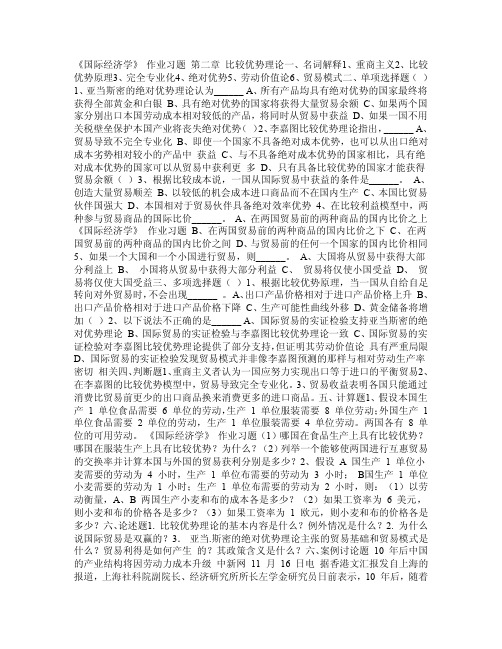
《国际经济学》作业习题第二章比较优势理论一、名词解释1、重商主义2、比较优势原理3、完全专业化4、绝对优势5、劳动价值论6、贸易模式二、单项选择题()1、亚当斯密的绝对优势理论认为______ A、所有产品均具有绝对优势的国家最终将获得全部黄金和白银B、具有绝对优势的国家将获得大量贸易余额C、如果两个国家分别出口本国劳动成本相对较低的产品,将同时从贸易中获益D、如果一国不用关税壁垒保护本国产业将丧失绝对优势()2、李嘉图比较优势理论指出,______ A、贸易导致不完全专业化B、即使一个国家不具备绝对成本优势,也可以从出口绝对成本劣势相对较小的产品中获益C、与不具备绝对成本优势的国家相比,具有绝对成本优势的国家可以从贸易中获利更多D、只有具备比较优势的国家才能获得贸易余额()3、根据比较成本说,一国从国际贸易中获益的条件是______。
A、创造大量贸易顺差B、以较低的机会成本进口商品而不在国内生产C、本国比贸易伙伴国强大D、本国相对于贸易伙伴具备绝对效率优势4、在比较利益模型中,两种参与贸易商品的国际比价______。
A、在两国贸易前的两种商品的国内比价之上《国际经济学》作业习题B、在两国贸易前的两种商品的国内比价之下C、在两国贸易前的两种商品的国内比价之间D、与贸易前的任何一个国家的国内比价相同5、如果一个大国和一个小国进行贸易,则______。
A、大国将从贸易中获得大部分利益上B、小国将从贸易中获得大部分利益C、贸易将仅使小国受益D、贸易将仅使大国受益三、多项选择题()1、根据比较优势原理,当一国从自给自足转向对外贸易时,不会出现______ 。
A、出口产品价格相对于进口产品价格上升B、出口产品价格相对于进口产品价格下降C、生产可能性曲线外移D、黄金储备将增加()2、以下说法不正确的是______ A、国际贸易的实证检验支持亚当斯密的绝对优势理论B、国际贸易的实证检验与李嘉图比较优势理论一致C、国际贸易的实证检验对李嘉图比较优势理论提供了部分支持,但证明其劳动价值论具有严重局限D、国际贸易的实证检验发现贸易模式并非像李嘉图预测的那样与相对劳动生产率密切相关四、判断题1、重商主义者认为一国应努力实现出口等于进口的平衡贸易2、在李嘉图的比较优势模型中,贸易导致完全专业化。
- 1、下载文档前请自行甄别文档内容的完整性,平台不提供额外的编辑、内容补充、找答案等附加服务。
- 2、"仅部分预览"的文档,不可在线预览部分如存在完整性等问题,可反馈申请退款(可完整预览的文档不适用该条件!)。
- 3、如文档侵犯您的权益,请联系客服反馈,我们会尽快为您处理(人工客服工作时间:9:00-18:30)。
Chapter 2 World Trade—An OverviewMultiple Choice Questions1. What percent of all world production of goods and services is exported to other countries?(a) 10%(b) 25%(c) 50%(d) 100%(e) None of the aboveAnswer: B2.What percent of all world imports of goods and services were exported?(a) 10%(b) 25%(c) 50%(d) 100%(e) None of the above.Answer: D3. What percent of all world consumption (private and public, including real investment) was imported?(a) 10%(b) 25%(c) 50%(d) 100%(e) None of the above.Answer: B4. The gravity model, that states that size matters,predicts that the weight of the traded good will________ related to its likelihood to be exported(a) be directly(b) be inversely(c) not be(d) All of the above(e) None of the aboveAnswer: E5. The gravity model offers a logical explanation for the fact that(a) Trade between Asia and the U.S. has grown faster than NAFTA trade.(b) Trade in services has grown faster than trade in goods.(c) Trade in manufactures has grown faster than in agricultural products(d) Intra-European Union trade exceeds International Trade of the European Union.(e) None of the aboveAnswer: D6. The gravity model suggests that over time(a) trade between neighboring countries will increase(b) trade between all countries will increase(c) world trade will eventually be swallowed by a black hole.(d) trade between Earth and other planets will become important(e) None of the aboveAnswer: E7. The gravity model explains why(a) trade between Sweden and Germany exceeds that between Sweden and Spain(b) countries with oil reserves tend to export oil.(c) capital rich countries export capital intensive products(d) intra-industry trade is relatively more important than other forms of trade between neighboringcountries.(e) None of the aboveAnswer: A8. According to the gravity model, a characteristic that tends to affect the probability of trade existingbetween any two countries is(a) their cultural affinity(b) the average weight/value of their traded goods(c) their colonial—historical ties(d) the distance between them(e) the number of varieties produced on the average by their industries.Answer: D9. The one single trade partner country of the U.S. is(a) United Kingdom(b) Canada(c) Mexico(d) Japan(e) IsraelAnswer: B10. In general which of the following tend to promote the probability of trade volumes between twocountries(a) Linguistic and/or cultural affinity(b) Historical ties(c) Sizes of economies(d) Mutual membership in preferential trade agreements(e) All of the aboveAnswer: E11. Since World War II (the early 1950s), the proportion of most countries’ production being used insome other country(a) remained constant(b) increased(c) decreased(d) fluctuated widely with no clear trend(e) both (a) and (d) aboveAnswer: B12. Since World War II, the likelihood that foreign markets would gain importance in the averageexporters’ as a source of profits(a) remained constant(b) increased(c) decreased(d) fluctuated widely with no clear trend(e) both (a) and (d) aboveAnswer: B13. Since World War II, the likelihood that any single item in the typical consumption basket of aconsumer in the U.S. originated outside of the U.S.(a) remained constant(b) increased(c) decreased(d) fluctuated widely with no clear trend(e) both (a) and (d) aboveAnswer: B14. Since World War II, the likelihood that the job a new college graduate will be directly or indirectlyaffected by world trade(a) remained constant(b) increased(c) decreased(d) fluctuated widely with no clear trend(e) both (a) and (d) aboveAnswer: B15. Since World War II, the relative importance of raw materials, including oil, in total world trade(a) remained constant(b) increased(c) decreased(d) fluctuated widely with no clear trend(e) both (a) and (d) aboveAnswer: C16. In the current Post-Industrial economy, international trade in services (including banking andfinancial services)(a) dominates world trade(b) does not exist(c) is relatively small(d) is relatively stagnant(e) None of the aboveAnswer: C17. In the pre-World War I period, the U.S. exported primarily(a) manufactured goods(b) services(c) primary products including agricultural(d) technology intensive products(e) None of the aboveAnswer: C18. In the pre-World War I period, the United Kingdom exported primarily(a) manufactured goods(b) services(c) primary products including agricultural(d) technology intensive products(e) None of the aboveAnswer: A19. In the pre-World War I period, the United Kingdom imported primarily(a) manufactured goods(b) services(c) primary products including agricultural(d) technology intensive products(e) None of the aboveAnswer: C20. In the present, most of the exports from China are in(a) manufactured goods(b) services(c) primary products including agricultural(d) technology intensive products(e) None of the aboveAnswer: A21. Which of the following does not explain the extent of trade between Ireland and the U.S.?(a) Historical ties(b) Cultural Linguistic ties(c) Gravity model(d) Multinational Corporations(e) None of the aboveAnswer: CEssay Questions1. When comparing the composition of world trade in the early 20th Century to the early 21st Century,we find major compositional changes. These include a relative decline in agricultural and primary-products (including raw materials). How would you explain this in terms of broad historicaldevelopments during this period?Answer: The typical composition of world production during this period experienced major changes. Focusing on today’s Industrialized Countries (primarily members of the OECD),the industrial-employment composition was focused primarily on agriculture. Most valuewas in land. The predominant single consumption category was food. Since then, theeconomies shifted from the agricultural to the manufacturing sectors (continuing trendsbegun over a century earlier in the industrial revolution). Incomes rose, and consumptionshifted in favor of (increasingly affordable) manufactures. Both income and priceelasticities were greater in manufactures than in agricultural products. At the same timethere was a steady tendency for synthetic (manufactured) inputs to replace agriculturalbased raw materials and industrial inputs. Hence, trade and of course international tradeconformed to overall changes in patterns of world production and consumption.2. In the past half century, the developing countries have experienced major compositional shifts fromexports of primary products (including agricultural and raw materials) to exports of manufactures.How might you explain this in terms of broad historical developments during this period?Answer: Any discussion of the export experience of the developing countries must first clarify the problem of definitional inclusion. In particular, the exports of the (non-OECD) developingcountries, has become increasingly dominated by the experience of a relatively smallnumber of countries in South-East Asia, termed the New Industrialized Countries (NICs).Since they experienced both very rapid increases in their exports, and very rapid increasesin the manufactured component of their exports, their experience alone may explain thebulk of the observed phenomenon. Many would exclude the NICs from the developingcountry category so as to be able to focus the discussion on a more representative sampleof (the over 100) developing countries. More recently, a second wave of East Asiancountries, notably including China have replicated the experience of the NICs, and thisagain muddies the water for one interested in focusing on the export experience of thegrowing heterogenous category, developing countries.Another explanation of the growing dependence on manufactured exports on the part ofthe developing countries, follows the answer to question 1 above. Since the consumer( including industrial consumer) markets in OECD countries were rapidly shifting awayfrom primary products, these markets were rapidly disappearing.In addition, in the world markets for primary products was generally limited by low priceand especially income elasticities; agricultural sectors tended to be highly and rigidlyprotected in potential OECD markets; and escalating effective tariff structures leviedsystematically large levels of protection against the primary exports of the developingcountries; success in world exports had to be pursued outside of the traditional primaryexports of these countries.3. The Neoclassical Heckscher-Ohlin model assumes that all producers of any industrial product hasknowledge of, and may avail itself of the same production technology available to producers in any other country. Many have flagged this identical technology assumption as an unrealistic assumption.During the past half century, the relative importance of the Multinational Corporations (MNCs) in world trade has steadily increased. How would this trend affect the realism of the “identicaltechnology” assumption?Answer: Noting that MNC plants tend to use more labor intensive production processes in co untries where labor tends to be relatively cheap (both in “low” tech , e.g. Nike, and“high tech,” e.g. Motorola), one may argue that MNCs use different technologies indeveloping countries. However, this is a gross misunderstanding of the identicaltechnology assumption . It is axiomatically obvious that if the same MNC is producingsomething in both labor abundant and labor scarce using different processes, itnevertheless has knowledge (intimate knowledge in the case of proprietary patentedprocesses) of available technology. The fact that the MNC may choose not to apply thesame degree of capital intensity in environments with greatly different relative factorprices in no way lessens the fact that the Heckscher-Ohlin identical technologyassumption is strengthened due to the growing relative strength of MNCs in developingcountries. An additional fact that strengthens this argument is that, as compared to theearly 1950s, a growing proportion of MNCs are themselves based in developing countries,such as China and Brazil.4. One of the major political developments of the past several decades is the growing size andeconomic/monetary integration of the European Union. What effect do you think this will have on international trade between countries?Answer: The growing economic integration between the various countries of Europe, both the old and existing members of the European Union (EU) and the new countries joining it(including perhaps soon, Turkey), means that the barriers to trade are steadily falling in aregion that has traditionally dominated world trade. The common monetary unit should initself go far to promote inter-country trade within the growing EU (judging by thepositive historical effect of a single currency in the U.S.). The standardization oftransportation (including railroad gauges, highway signs etc.) and product codes will alsopromote expansion of intra-EU trade. The decline in the probability of political conflictassociated with this comprehensive economic union, plus conscious attempts to cooperatein fiscal and monetary policy stances again point to growing international trade, allowingthese countries to increasingly enjoy the fruits of potential positive scale economies, andmore traditional classical and neo-classical gains from trade. The scale economies willalso tend to increase trade between the EU and other countries.5. The Services sector has been steadily rising in relative importance in GDP of the United States, aswell as elsewhere around the world. Since “services” have been identified as “non-tradables” (e.g. it is difficult to export haircuts), it may be argued that this trend will likely slow the rapid growth in international trade. Discuss.Answer: This argument stands on questionable logical foundations. The past half century has seena steady growth in the absolute and relative importance of international trade. This trendhas been reversed only by global conflicts, i.e. the two World Wars. This trend hasremained steady and robust despite major compositional shifts (e.g. from primary tomanufacturing), and location shifts (e.g., the sudden rise of NICs as significant group ofexporters). The trend will probably continue into the reasonable future, fueled by bothsuper-regional preferential trade regions and a growing impact of the multilateral forces,represented institutionally by the World Trade Organization (WTO)—as illustrated by therecent abolishment of the epitome cartelized trade, the world trade in textiles. Driven bytechnology—especially in the areas of communication and transportation—a reversal ofthe growing trade trend is not likely in the near future. In any case, many “services” are infact quite tradable. Examples would be financial services, long-distance teaching, “help-desk” outsourcing, consult ing and management services and others. In fact, when a touristgets a haircut, we see that even haircuts become a “tradable” service.。
